September 13 - 19, 2015: Issue 231
Cedric Vincent Williams
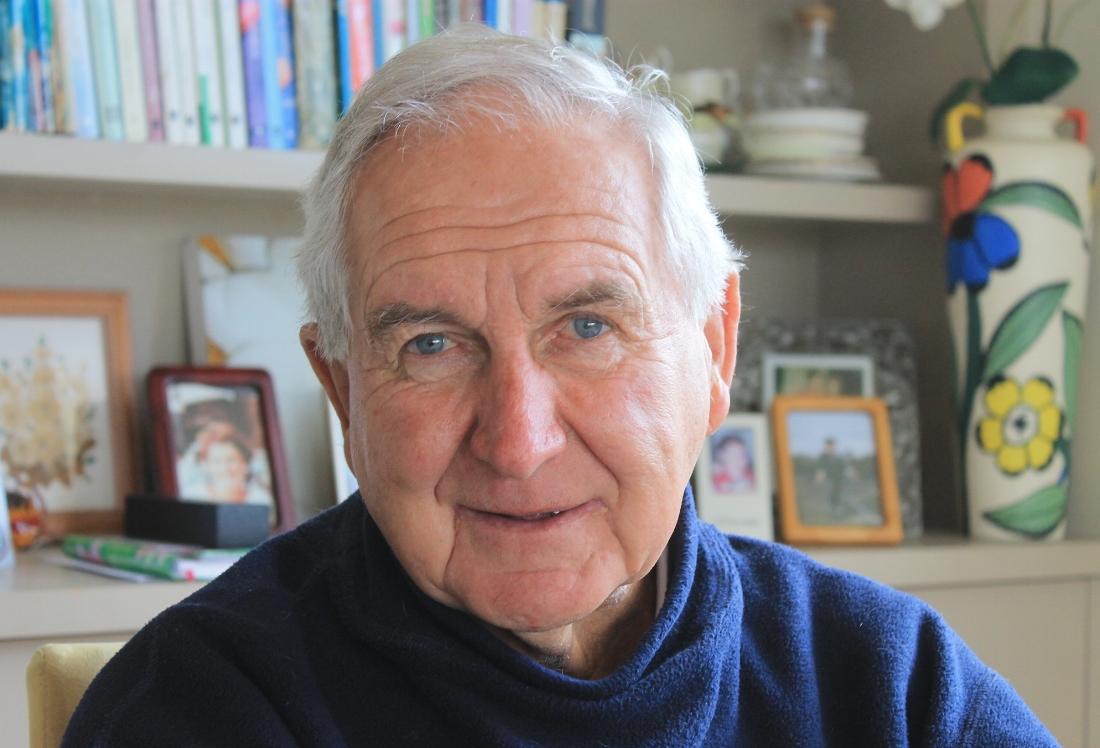
Cedric Vincent Williams
The son of legendary Pittwater sculler, rower, shipwright and sailor Cedric Morton Williams, Cedric Vincent Williams, has 77 years on or near Pittwater this coming Friday, September 18th - Happy Birthday to you, dear sir!
The epitome of a saltwater man, Cedric has to be near the water. After a lifetime of building boats, he still has not had his fill and gets on the water and over towards the greener National Park shores whenever he can.
Mr. Williams has witnessed the beginnings of BYRA, he has seen what Pittwater was like during World War II and watched the green fields and old boatsheds change into crowded foreshores. It's still the same though, he still sees the beautiful landscape and the people in this place are still the same too - there's a reason we all come here and stay here:
Where and when were you born?
I was born in Manly on the 18th of September 1938. we moved two days later to Bayview. I lived in Bayview all of my young life. We then moved further around in Bayview.
My father was Cedric Morton Williams whereas I’m Cedric Vincent Williams – Vincent came from my uncle who lived at Avalon before you could actually get there by road and had to go by boat. The Foxes were the family who lived there – Neville Fox became a very good rower too, like dad. My mother lived there, and married my father of course – and my mother’s brother married my father’s sister.
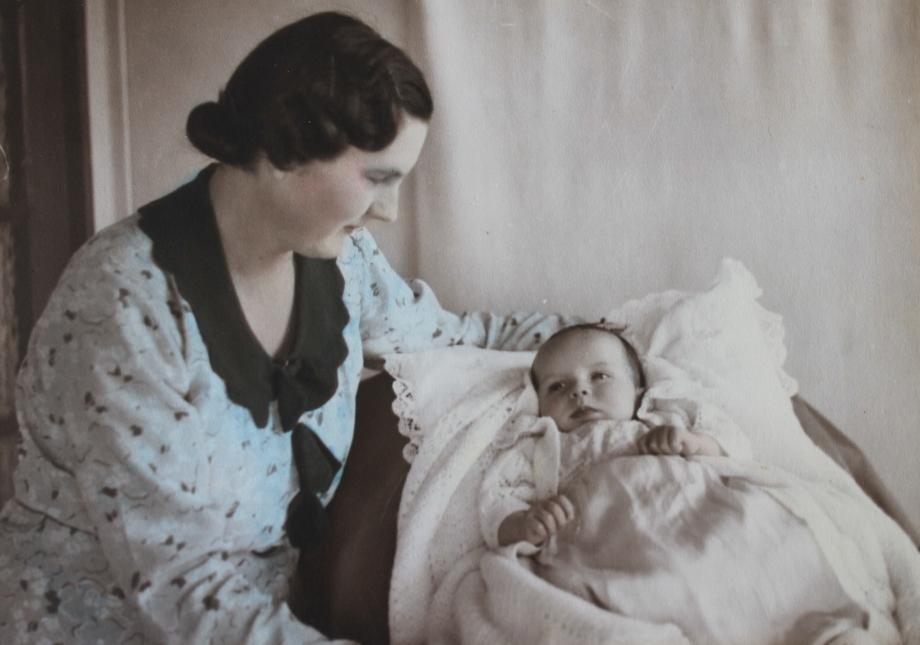
Cedric with his mother - Sophie Williams, nee Fox
What was it like growing up in Bayview – what did you do for fun?
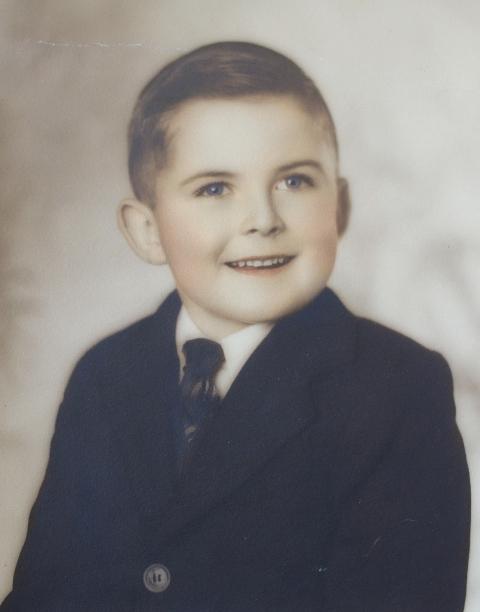 Bayview was a strange spot as the only way you could go to school was to go to Mona Vale. There was only 8 to 10 young people in Bayview at that time. We went over the hill, into the bush occasionally, but I was mainly on the water.
Bayview was a strange spot as the only way you could go to school was to go to Mona Vale. There was only 8 to 10 young people in Bayview at that time. We went over the hill, into the bush occasionally, but I was mainly on the water.
My father had the boatshed and the boat building business and so I’d go down to the boatshed most of the time.
When I was at school I was building VJ’s – so I’d get home from school and build boats. I went from Mona Vale school to Manly High, which had just moved into Harbord when I was in my 3rd year. My apprenticeship then came back to Bayview so I worked at Bayview form then on.
All I’ve known is Bayview really, and boats. I’ve lived around the water. It was a pretty easy life but restricted in terms of ever since I was born I was going to be a boat builder – a shipwright – and take on the business, which I did.
My father died when he was only 68, in 1971, so I took the boatshed over and kept it going until I sold it in 1989.
Being born in 1938 – were you conscious of any the war restrictions at Bayview – the pylons put up around the water edge to stymie feared invasions?
Yes. They were trying to stop the Japanese coming into Pittwater. There was a net across the mouth of Pittwater, which you had to go through if you wished to go out to sea. I used to go fishing a little bit then and I remember hating having to go through that net gate.
I remember my father used to go fishing at that time with some of the local people and I too would go out sometimes. I always remember the fact that you had to go through the gate to get out to sea – we didn’t do this very much as no one wanted to be out in the ocean at that time with so many Navy vessels and possible submarines and enemy ships out there.
I remember we’d fish underneath West Head and the guns would be up there and they’d point them down on us! So I knew they were there.
When we were living further towards the Mona Vale end of Bayview the Army were there. We lived in Roche Avenue – just up from where the Tennis courts are now. The Army were camped further along, where the dog park is now – there were three houses, ours included. They had their tents there, all along there, so you were conscious of the Army being about. We weren’t allowed to have much to do with them of course.
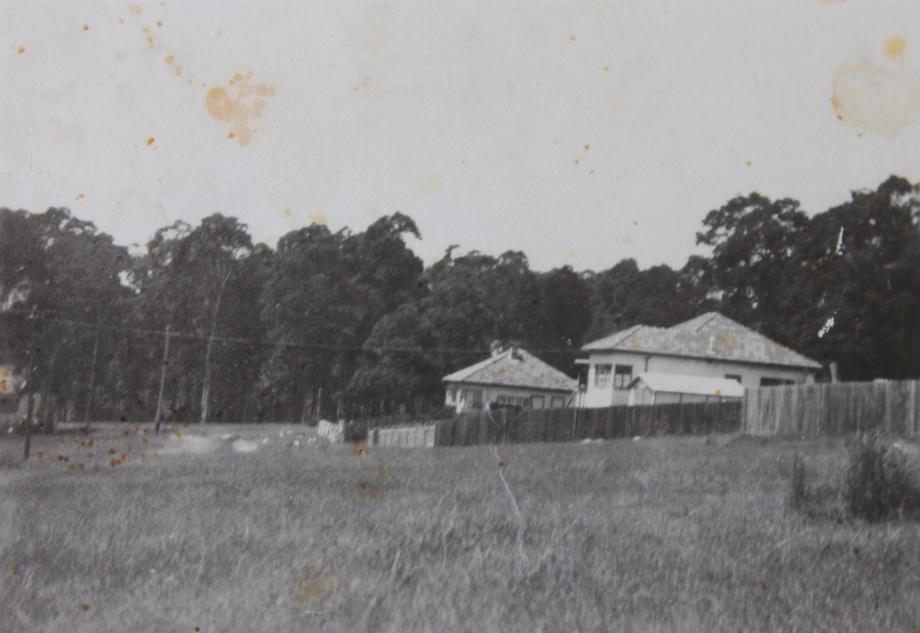
Williams Home - Bayview
Where they’ve filled in now, where the dog park is at Bayview, a little back from that there was once a big factory where they were dredging sand which would be taken off to make glass and things like that, and this all during that war period too. We’d play in that area.
There was a big sand flat there where the park is now.
From Bayview Golf club to where the creek ran out was a no area – it was all mud and mangroves. We wouldn’t go in there much – I had a canoe and would go along some of the creek but I was mostly on Pittwater.
Apart from having the net and gate to stop people at the Palm Beach end they put stops around the edges of Pittwater – these concrete pyramids. They were great heavy things they dropped in so nothing could go over them. They used to go all around the foreshores. Eventually they kept sinking down into the mud of course, and there is a lot of them still under the mud even now. They had great big steel loops on them.
My father would get them and make moorings out of them – they could never move, once they were put down they were there, permanently. The only way he could do it was get two dinghies together, wait for the tide to come in to lift it, tie the pyramid concrete onto it, then cut it – a couple of times the dinghy was sinking just as much as the pyramid!
That was one interesting part of local activities during the war.
Loquat Valley School, where that is, was just a thoroughfare which they blocked up. There was a little bit of wharves at the end of the track for the army there – so the Army was fairly prevalent in the area then – you were conscious of them being everywhere.
I also remember at the end of the war P G Taylor brought three Catalina planes down to Bayview. They were delivered to the boatshed and we put them on moorings there. The Navy took the engines and gave the rest to dad who took some of them for parts – the anchors were still great, as was the steel. Dad used them in boats.
PG Taylor put one together out of all three and it was placed in Catalina Park in the Blue Mountains – dad knew the manager of the Guest House up there at Katoomba.
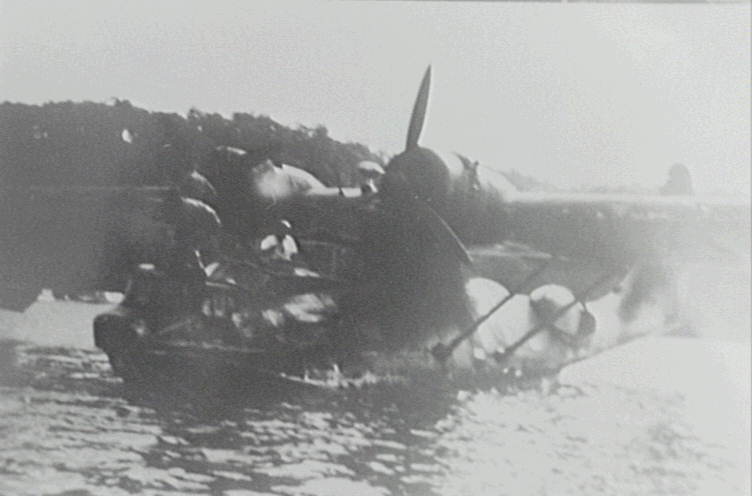
Flying boat owned by P. G. Taylor in water near Bayview. - Image courtesy Mona Vale Library: Local History Collection
Were you conscious that your father was a Champion rower?
No. he’d finished when I was born and then the war came. The Pittwater Aquatic Club was all finished by the time I came along too.
When he was a rower he’d always wanted to go to the Olympic Games. They had the championships in Melbourne, and he did well, but was disqualified as he was considered a professional rower – if you built your own boat you were a professional. He was reinstated as an amateur but didn’t get to row because the war was on.
He lent his boat to Chas Prince Birra, who has raced in the Olympics, and he was a professional car race driver prior to that, but Prince was never a professional,. So he could go in the Olympic Games. There were a lot of fights that would go on.
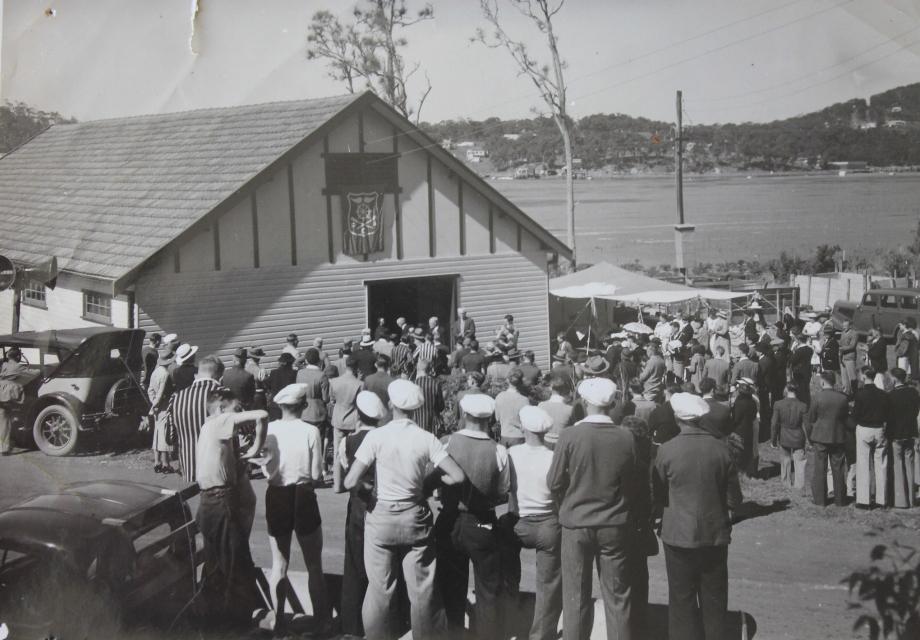
Pittwater Aquatic Club 1930's (where Bayview Sea Scouts hall is now) - Cedric William's photo
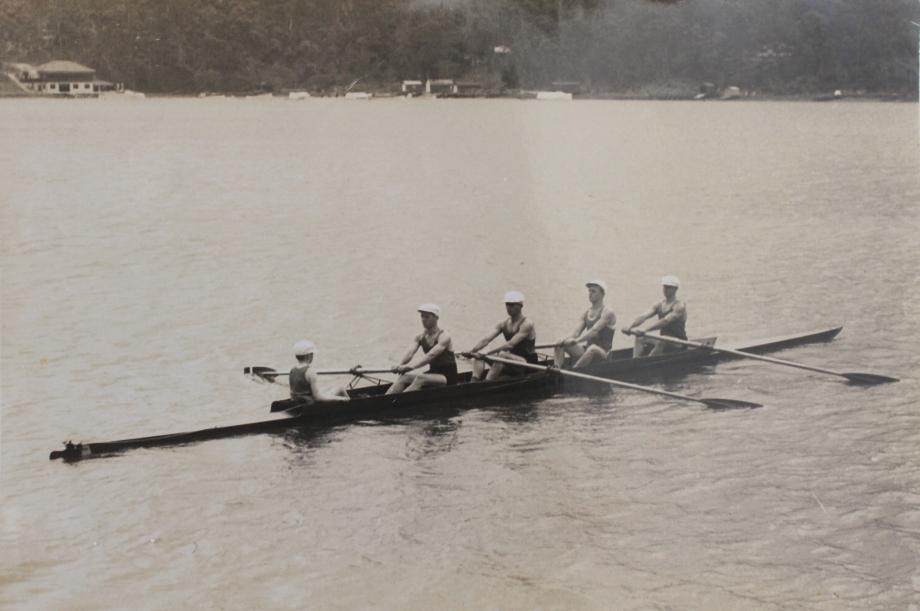
On the Pittwater - Second Royal Motor Yacht Clubhouse at Newport in background
He started sailing, and racing in sailing – that’s how BYRA started.
There was a race between the people who used to sit at his bench in the boatshed and one day when K C Dalton came down – they would always give him a hard time – he said ‘I’ve got my boat out there and it’s good – if you want to race that’
Dad said ‘I’ll race you around Lion Island’.
I was 11, it was November, and the race was on a Wednesday – the whole of this area had closed down. We raced around Lion Island and my father won quite easily. We had only one sailing chap in it – all the rest were old scullers.
K C Dalton had his crew, and my uncle Jack, he was actually John Williams but everyone called him ‘Jack’, went with him, but all the rest were these old guys that would sit down at the wharf all the time.
So that’s how BYRA started, through that race. That was November 1949. They started racing the big boats to begin with, on a Sunday. They bought the boatshed, which is still standing in the same place now but it was only a little boatshed then, two storeys, and they built BYRA out of that.
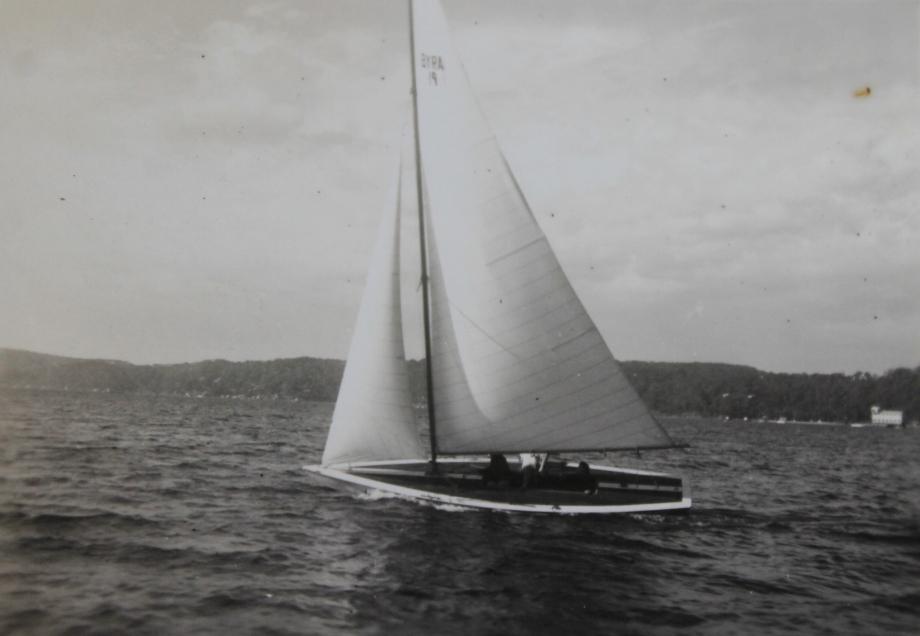
Cedric M Williams, Sailing on Pittwater in early BYRA boat.
It was next door to Riddles – you had the Riddles boatshed, then some rubbish, then this little boatshed. The Riddle sisters were still living there at that stage but they weren’t still running the shop then. Darkie Griffin had the boatshed a bit further around, my father had the one at Bayview and then Baker bought the shop from Cowells and then he too started going into the boat industry.
My father, being a boat builder in the area, knew all the older people in the area, all of whom would come to the boatshed everyday. There was nowhere else to go. They used to sit down on the wharf or at this bench he had there, he couldn’t work half the time because they were always there.
My father was a very precise man, who didn’t drink or smoke, but had these people around him all the time, and I got to know them this way. He’d be working away, or trying to. This was a very old boatshed, with a timber roof – I’d get up in the roof and get timber from there as it as better than what I could buy. I’d cut bits of timber from there to build my boats with. It all fell down after a while and we built a new boatshed there.
In BYRA, after the big boats they developed the Star Class. From the Star Class it went to Dragons. I was a bit older by then and playing a lot of tennis and squash at that time as some kind of outside sport as the rest of the time, 7 days a week, I was at the boatshed and wanted something outside of that.
I came back to sailing and was sailing in Etchells then, when training.
I remember sailing in VJ’s, the junior championships. We won a few junior championships.
What was the first boat you built?
My first boat was a VJ, I called her ‘CV’, from ‘CVW’. I was 11 when I built my first boat. I had quite a lot of other boats after that as I’d just build them and sell them.
What was the best aspect of seeing BYRA develop for you?
It just grew – it was a little shed. I’d always sail from my place at Bayview around to there and then take off. They had extra boats there, and the club got bigger and bigger – Jimmy Overy used to bring a lot of boats down there.
There was a problem in that Palm Beach was VJ’s, as was Avalon, but those at Avalon/Clareville were different VJ’s in that they had bigger spinnakers. We had a 40 square spinnaker and they had 60 square spinnakers. They sailed from Clareville, so we didn’t sail much there, we’d go to Palm Beach and sail against them because they were the same standard. I did this until I was about 17 and then went into the Etchells and sailed in these until around 1995 out of the Royal Prince Alfred Yacht Club.
Unfortunately then I had an accident which led to me being told not to sail anymore.
The boatshed then changed from strictly boatbuilding. I was still building boats in the new building. We built a 60 foot boat for a chap named Lennon, which was a very special boat – the ‘Murray’. We actually took Princess Alexandra out in this boat down in the Port Hacking area. It then went to Noumea and was sunk over there – I think it ended up on a wharf over there.
We pulled the old boatshed down when I was 20 and put up a new boatshed, 1958 that would have been.
When we built the new marina, the person who did it was a relation of ours who brought in this big window and this was etched on it. when we left Church Point 18 months ago we were too frightened to get this window out in case we broke it so we left it, took a photo of it and this is the actual photo and I made the frame up for it.
It took us 18 months to build this one, the Murray – there was only the two of us building it of course.
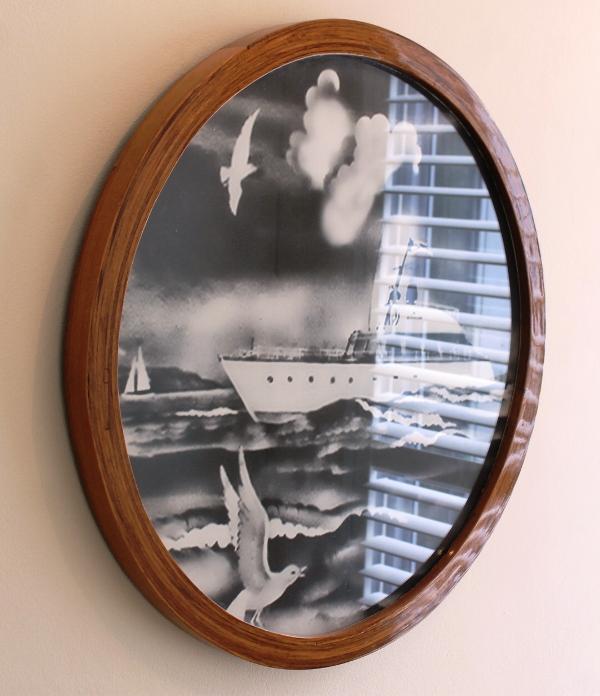
The copy of the window - Cedric: 'That’s actually got Princess Alexander’s flag on it there'
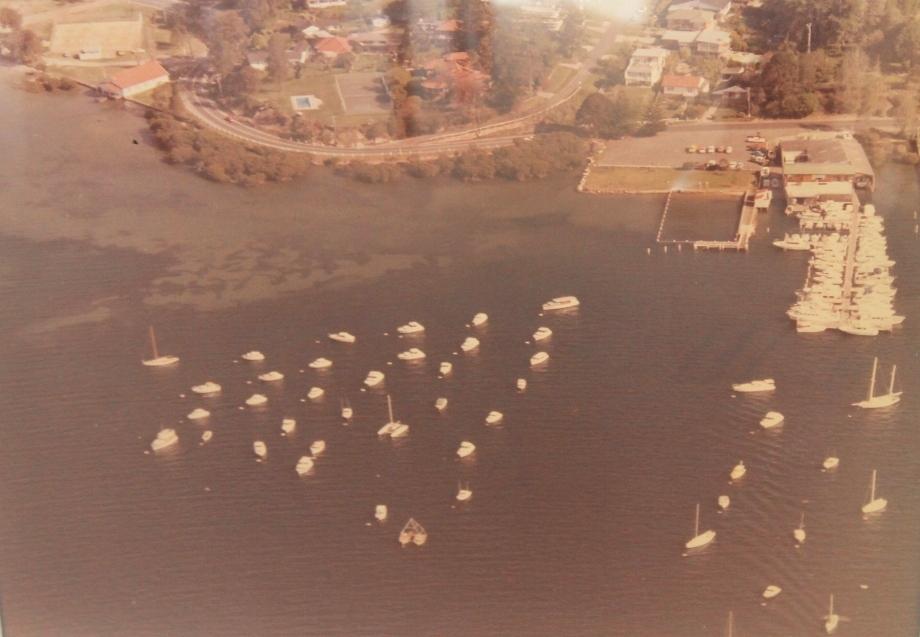
Cedrics photo of new boatshed
What makes a good boatbuilder or shipwright?
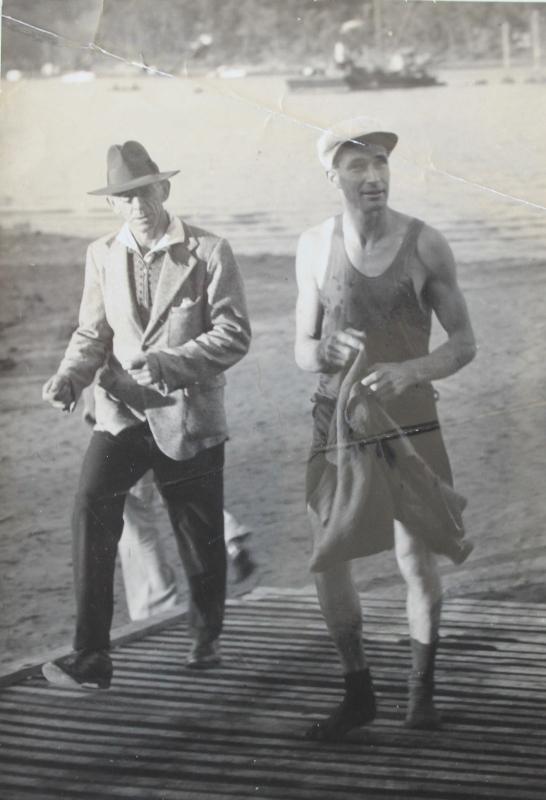 I was good at woodwork from the very start, so I think that helped. And always being around it, you pick things up so it becomes like a second nature in some ways. When my father was building a boat, say he knew it would be a 60 footer – he would get a bit of timber and cut a half model and build it from that – he wouldn’t know where the waterline was going to be until a month before its launch.
I was good at woodwork from the very start, so I think that helped. And always being around it, you pick things up so it becomes like a second nature in some ways. When my father was building a boat, say he knew it would be a 60 footer – he would get a bit of timber and cut a half model and build it from that – he wouldn’t know where the waterline was going to be until a month before its launch.
When you’re looking at things, or what he did, was line everything up with his toe so it was straight and build on either side of that – he would do this even when watching television. They used to all him ‘Sea Rederick/C Rederic’ because he was the Commodore of the club and was always organising everything associated with that and did a few other things for the community.
Up until I was about 17 my father didn’t really communicate with me that much, he was only interested in the boats. Then when I came into the business he was great as he gradually eased out of the business and allowed me to take it over, the boatshed and the building of boats, the designing of boats.
Right: Cedric M Williams as young rower circa 1930 (Older gentleman used to help with rowing)
Some of the aspects of the way I designed things were a new and different way of doing this – an example was putting the windows the wrong way – the sloping of windows always went one way and I put them the opposite way, something cars developed later as well – the windscreens used to fold back – so our boats were doing that prior to this being adopted.
That big 60 footer, which we didn’t have plans for, was one of my first designs. I was going to Tech while we were building that. My teacher said my project for that year would be to do all the plans for that boat and in doing so, he showed me the proper way to draw plans for boats. This was great as I was actually studying what we were building at the time – I did all the plans for the interior.
I was Apprentice of the Year – and learned much in adapting full time into this world of boats.
My apprentice was Bill Barry-Cotter for the last three years of his apprenticeship and once we were done he took a lot of our equipment. He is probably one of the best boat builders in the world now – he sold his business for quite a bit recently some say, so that’s a fair indication of the standards he reached and his developments in shipwrighting.
It’s funny, when he went to Tech the teacher would report to us ‘he goes to sleep, he’s not going to get anywhere!’
Truth was he couldn’t be bothered with the Tech teachers as he knew more than they did.
That was a problem for many who grew up doing this, when they went to Tech they were already shipwrights, there was no such thing as boat builders – they were shipwrights, who worked on ships, and because there weren’t enough of us around to have a special class just for boat builders they all became shipwrights. Out teachers were shipwrights.
They would say ‘this is the way this has got to be done’ and we’d get into strife all the time using our ‘sight’ method. Fortunately, as I said, my Tech teacher liked me and through getting me to draw plans led me to making these new ideas work, ideas he thought were good and should be used elsewhere.
What is your favourite timber to work in when building boats?
Well, it goes back a little further than that. When we built that boat we put a beech deck on it, Beech was an Australian timber that was a bit like teak, they have stopped doing this now – it was a little whiter and the decks would come up whiter as a result. Beech is a very good timber for the outside as it doesn’t rot. All the inside was Australian cedar - Australian cedar is a beautiful timber. I use teak a lot now because you can’t get Australian cedar anymore – I have a plank that’s that thick and about 20 feet long.
When we built VJ’s we’d build special fins for the rudder that would fold up and these would be made out of Australian cedar. It’s a great timber, very light, resilient. Teak may be a better timber but it’s not Australian and you tend to like or want to use the Australian timbers when you’re building Australian boats – at least we did.
It’s simple really – I love boats, I just love boast. If I go to Brisbane I’d much rather go by boat – if I go anywhere, I’d rather go by boat.
Are you still doing the long trips?
Not so much now.
What is one of your more memorable longer cruises?
We picked a 57 feet long Grandbanks up in 1994 and brought that back from Freemantle. Carl Gonzales came on that trip with me. Carl was a fantastic guy – he sailed with me on the Etchells, loved his fishing – he loved his boats, loved his wife Caressa too, adored her.
The boat I have now is called Angelina.
What changes have you seen in Pittwater – you have witnessed it go from being fields to a suburban area?
There were a fair amount of people living in Bayview, the Moodys and Alexanders. You had the fishermen be there, Bobby Young had a place there and his father had a place there – one of those little sheds. People knew if you wanted fish to go there, there were fishermen who were making a business there. That’s all gone now.
Scotland Island was a place where a few people lived there but most of those who had places there were people who came for the weekend.
At Church Point the Pasadena was already there while I was young, as was the shop and this hasn’t changed much at all. Mitchell’s had the boatshed alongside this – there was Mitchell’s, then Darkie Griffin and our place and that was all the boatsheds that were along there until you went to Church Point.
Every Christmas everyone would go, all those who worked on the water, to all the old boatsheds in the area. You’d eat prawns and oysters there for as long as you like – they didn’t fight, they had a great time together – this was at Bayview – Palm Beach was considered a fair way away then.
Jack Gale used to say about my father ‘he taught me lots of things – I was a boy in the area.’ Jack and I used to go out in the dinghy and row the boats in to put them up on the slips. That's changed - they don't do that anymore.
Our boats were mainly cruisers even though dad was a sailor.

Williams Shipwright's - The Slips
In my era there was an old chap called Jim Shaw who had the blacksmith place on the corner of Bayview and Mona Vale – where the golf club is now. He and his sisters were there. He had an old motorbike, which would only go in one working gear, and a boat alongside the old boatshed, he’d come down everyday to work on that. He used to talk about the days when he used to have to take a bull in the punt/boat to the Royal Easter Show – they’d walk it from here to there, he couldn’t ride it because it wouldn’t let him get on it. He had to wait for the ferry to go across on the other side of The Spit because there wasn’t a Harbour Bridge yet in those days – so he’d walk up that hill and over through Mosman too.
So it’s all those type of things you think of and remember when asked about how it was when I was young.
When I drive along Pittwater road now, you may see more houses, more cars, but it’s still Pittwater road. If you go down to Church Point, past The Pasadena, you can still see in that section the lines that are cut off where the little slipways went, they’re still there if you look.
Where we used to live at Church Point was once called ‘The Green Frog’ – or next door to that, it was all finished by the time I came along. We actually bought a half of The Green Frog area, so the people next door had the building which had been The Green Frog. It’s still the same building although it’s been completely changed and renovated – the bones of the original are there though.
Church Point was still a long way from Bayview then, or where we were was – the Green Frog is about 10 to 15 houses further along from where the cemetery is now.
What are your favourite places in Pittwater and why?
I like Towler Bay, which is called ‘Morning Bay’ now. I like it because my parents lived there, and my grandparents lived there. The boat I brought across from Freemantle I had up until 18 months ago, and we’d go across there in that and be in that section they would be in – it’s similar to what it was like then, so it’s home to me.
Church Point is another. When my auntie was 100 I’d go to the nursing home and pick her up and take her out to Church Point and we’d look across to Towler Bay.
Towler Bay is my little place where I can get away from everything and it’s still pretty natural, it feels like home to me.
The Basin is a place where people went to too. If I was going away tonight for a quick trip I’d go across to Towler’s though.
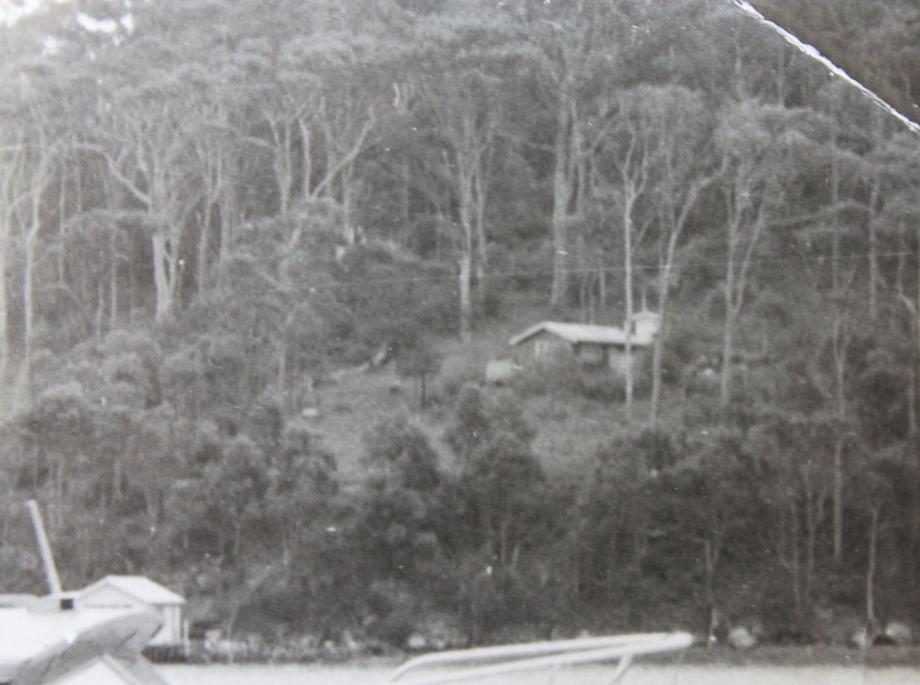

Family and Friends gathering at The Basin
We also used to go up the river (Hawkesbury) and would stay in America’s Bay and the Cowan Creek as that too is so natural, and like the original Pittwater still.
If you have seen that film The Two Rivers, although not a true story, it’s based on similar stories where people left Sydney in a boat, went up the Hawkesbury and settled there; they could still film that now as much of it is still unchanged.
What is your ‘motto for life’ or a favourite phrase you try to live by?
The basic thing for me would be that you have got to have something to do with the water. For me I have to be continually be on the water and I think for everyone, the more they’re near the water the better off they’ll be – not underneath the water, I hate swimming.
Having lived here all my life I can state I’ve been to Mona Vale Beach probably five times in my life. I don’t like the ocean, I’ve fallen off boats when out at sea – and when racing with Robyn, who has been my partner for decades now, I’ve fallen off in Pittwater too and I don’t like it – I want to get back on the boat as quickly as possible.
I love being on the water, not in the water.
So I think everyone benefits from being on the water – and for me, not in the water.
Having spent your whole life being what would be termed a ‘saltwater man’ – what do you think it has given you?
It has given me a lifetime of being barefooted – when I sold boats, some brought from New Zealand even, or a chap we used to deal with in Melbourne, Savage Boats, he used to come up and say ‘you’re always bare-footed and the chap in Sydney doesn’t wear a shirt – it’s a funny place this Sydney’ – and he came up here to live, changed his whole life.
So, you have got to be on the water and barefooted – if you can walk around on boats in bare feet then your balance will always be very very good.
I love being on the water and I love seeing the natural side of Pittwater – it hasn’t changed very much and is still looked after by everyone here to keep it so. Keeping the houses so they are hidden a fair bit by the bush.
Physically it’s great being here in this environment, and that also benefits my emotional side, I’ve had the mental challenge in designing and building boats, boats and being on top of the water have been my whole life. I still like going down the front here and playing on a boat. I think I get more satisfaction out of being close to the water, I have to be able to see the water, smell the water.
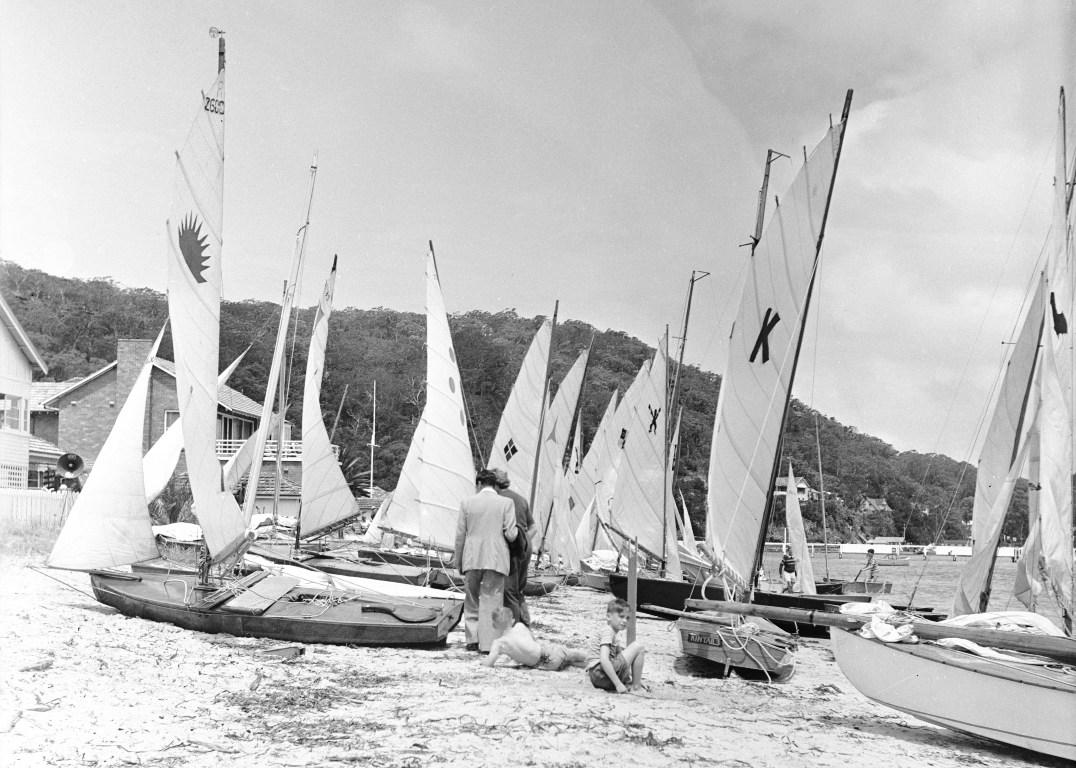
Pittwater - VS VJ State Titles December 1953 Object number 00013587 - Image courtesy Australian National Maritime Museum
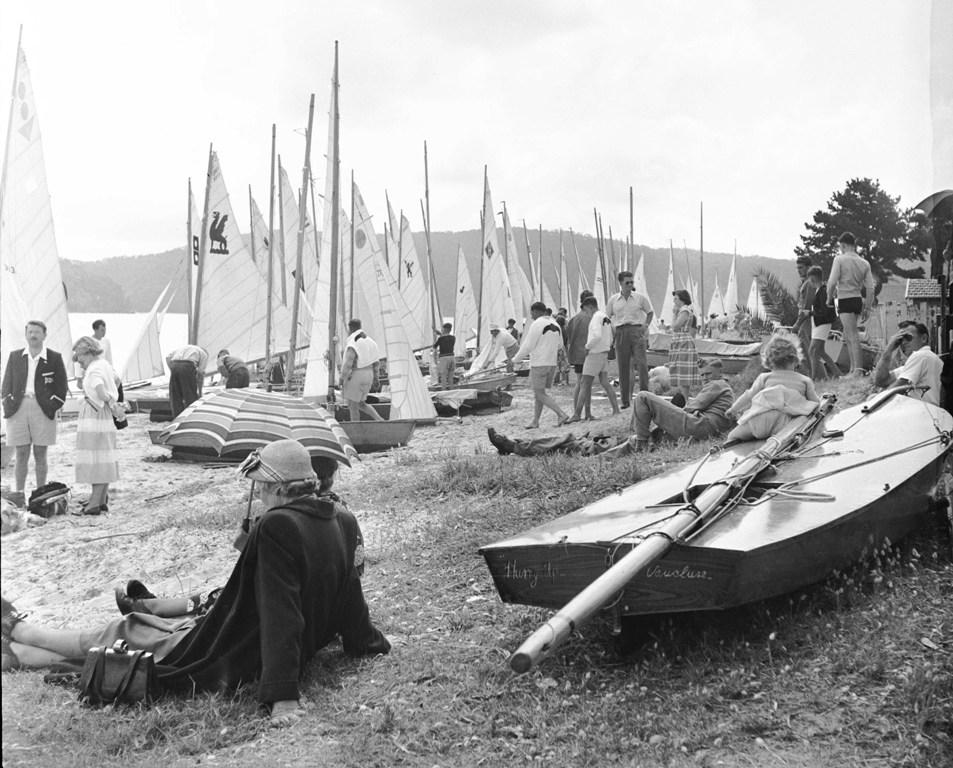
Vee Jays line the shore at Pittwater during the 1952/53 State Titles - Object number 00013584, courtesy Australian National Maritime Museum - Sandy Point Palm Beach
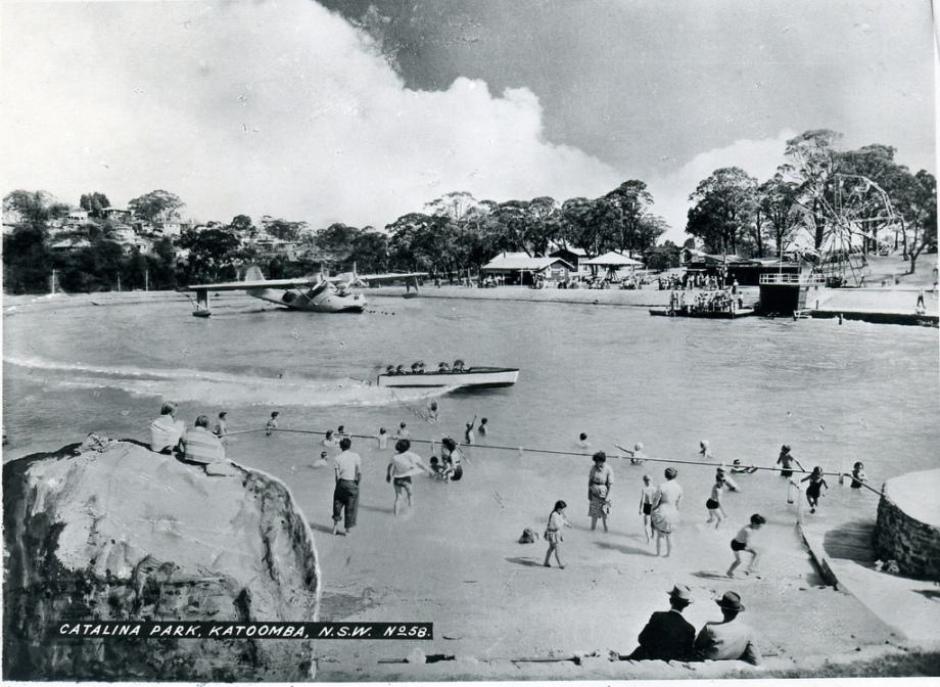
Catalina Park, Katoomba c.1950
Looking south east, showing the Catalina flying boat on the swimming lake, speed boat ride, fun fair, Ferris wheel, "monkey house" shelter constructed of cement over wire netting in the foreground.
The land was purchased by Horace Gates owner of the Homesdale Guest House and Wentworth Cabaret who, in 1946, felt that a new attraction was needed to bring tourists back to the Blue Mountains after peace was declared. Accordingly he dammed Katoomba falls creek and had an ornamental lake and amusement park constructed offering ‘every facility for fun and food’.
The park was an instant success and in 1948 the shell of a Consolidated Catalina PBY-5 flying boat was added to the attractions which included speed boat rides, tea rooms, miniature train, Ferris wheel, merry-go-round, swimming pool and a Giggle House showing Charlie Chaplin films. Although many people believed the plane had flown there, it had in fact been dismantled and brought to Katoomba by truck, where it was re-assembled and anchored to a concrete block in the middle of the lake.
Up to thirty passengers paid two shillings each to be taken out to the flying boat by punt where, in the dark, stuffy interior, they viewed film of a flight over Sydney, heard the story of the Catalina and tried out the controls. While the film was showing, an assistant would stand on the wing rocking the plane to simulate flight while the speed boat would circle the lake providing waves and engine noise. Fun seekers emerged from this surround sound experience dizzy and gasping for air, many too ill to enjoy further amusements.
For many years the lake operated as Katoomba’s swimming pool and provided a fireworks display after the New Year’s Eve street parade, however as the town’s population increased, it gradually became run down and the water polluted.
Blue Mountains City Council purchased the land in 1952 with the purpose of turning the area into a public park and treated water swimming pool. In 1954 the Catalina, showing signs of age and wear, was pulled up onto the bank and left to the ravages of weather and souvenir hunters, until in 1958 it was sold to Sheffield Welding & Engineering, Auburn NSW, where it was dismantled and cut up for scrap.
Courtesy Repository: Blue Mountains City Library www.bmcc.nsw.gov.au/library/ - Part of: Local Studies Collection